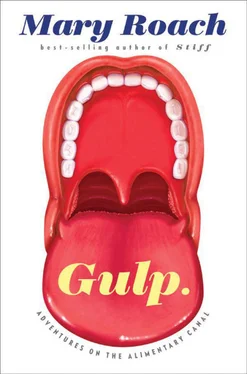I mention the CSPI rankings to Nancy Rawson. We are back at AFB headquarters, with Moeller again, in a different conference room. (There are five: Dalmatian, Burmese, Greyhound, Calico, and Akita. The staff refer to them by breed, as in, “Do you want to go into Greyhound?” “Is Dalmatian free at noon?”) It would seem that in terms of nutrition, there was no difference between the cheap meatball sub I ate for lunch and the SmartBlend the dogs were enjoying earlier. Rawson disagrees. “Your sandwich was probably less complete, nutritionally.”
The top slot on the CSPI scorecard, with 172 points, is beef liver. Chicken liver and liver sausage took second and third place. A serving of liver provides half the RDA for vitamin C, three times the RDA for riboflavin, nine times the vitamin A in the average carrot, plus good amounts of vitamins B12, B6, and D, folic acid, and potassium.
What’s the main ingredient in AFB’s dog-food palatants?
“Liver,” says Moeller. “Mixed with some other viscera. The first part that a wild animal usually eats in its kill is the liver and stomach, the GI tract.” Organs in general are among the most nutritionally giving foods on Earth. A serving of lamb spleen has almost as much vitamin C as a tangerine. Beef lung has 50 percent more. Stomachs are especially valuable because of what’s inside them. The predator benefits from the nutrients of the plants and grains in the guts of its prey. “Animals have evolved to survive,” Rawson says. They like what’s best for them. People blanch to see “fish meal” or “meat meal” on a pet-food ingredient panel, but meal—which variously includes organs, heads, skin, and bones—most closely resembles the diet of dogs and cats in the wild. Muscle meat is a grand source of protein, but comparatively little else.
Animals’ taste systems are specialized for the niche they occupy in the environment. “That’s driven their sensory systems down a certain path,” Rawson says. This includes the animal known as us. As hunters and foragers of the dry savannah, our earliest forebears evolved a taste for important but scarce nutrients: salt and high-energy fats and sugars. On the African veldt, unlike at the American food court, fats, sugar, and salt were not easy to come by. That, in a nutshell, explains the widespread popularity of junk food. And wide spreads in general.
Like dogs, humans also need a broad range of vitamins, minerals, calcium. We’re omnivores. Early man didn’t throw away the most nutritious parts of a carcass. Why ever do we? In 2009, the United States exported 438,000 tons of frozen livestock organs. You could lay them end to end and make a viscera equator. Figuratively speaking, they already ring the globe. Egypt and Russia are big on livers. Mexico eats our brains and lips. Our hearts belong to the Philippines.
What happened here? Why are we so squeamish? How hard would it be to go back to our healthier origins? For answers, we head to the Canadian Arctic, last stronghold of the North American organ-meat dinner.
3. Liver and Opinions
WHY WE EAT WHAT WE EAT AND DESPISE THE REST


THE NORTHERN FOOD Tradition and Health Resource Kit contains a deck of forty-eight labeled photographs of traditional Inuit foods. Most are meat, but none are steaks. Seal Heart, one is labeled. Caribou Brain, says another. The images, life-size where possible, are printed on stiff paper and die-cut, like paper dolls that you badly want to throw some clothes on. The kit I looked through belonged to Gabriel Nirlungayuk, a community health representative from Pelly Bay, a hamlet in Canada’s Nunavut territory. Like me, he was visiting Igloolik—a town on a small island near Baffin Island—to attend an Arctic athletic competition. [18] The Inuit Games. Most are indoor competitions originally designed to fit in igloos. Example: the Ear Lift: “On a signal, the competitor walks forward lifting the weight off the floor and carrying it with his ear for as far a distance as his ear will allow.” For the Mouth Pull, opponents stand side by side, shoulders touching and arms around each other’s necks as if they were dearest friends. Each grabs the outside corner of his opponent’s mouth with his middle finger and attempts to pull him over a line drawn in the snow between them. As so often is the case in life, “strongest mouth wins.”
With him was Pelly Bay’s mayor at the time, Makabe Nartok. The three of us met by chance in the kitchen of Igloolik’s sole lodgings, the Tujormivik Hotel.
Nirlungayuk’s job entailed visiting classrooms to encourage young Inuit “chip-aholics and pop-aholics” to eat like their elders. As the number of Inuit who hunt has dwindled, so has the consumption of organs (and other anatomy not available for purchase at the Igloolik Co-op: tendons, blubber, blood, head).
I picked up the card labeled Caribou Kidney, Raw. “Who actually eats this?”
“I do,” said Nirlungayuk. He is taller than most Inuit, with a prominent, thrusting chin that he used to indicate Nartok. “He does.”
Anyone who hunts, the pair told me, eats organs. Though the Inuit (in Canada, the term is preferred over Eskimo ) gave up their nomadic existence in the 1950s, most adult men still supplemented the family diet with hunted game, partly to save money. In 1993, when I visited, a small can of Spork, the local Spam, cost $2.69. Produce arrives by plane. A watermelon might set you back $25. Cucumbers were so expensive that the local sex educator did his condom demonstrations on a broomstick.
I asked Nartok to go through the cutouts and show me what he ate. He reached across the table to take them from me. His arms were pale to the wrist, then abruptly brown. The Arctic suntan could be mistaken, at a glance, for gloves. He peered at the cutouts through wire-rim glasses. “Caribou liver, yes. Brain. Yes, I eat brain. I eat caribou eyes, raw and cooked.” Nirlungayuk looked on, nodding.
“I like this part very much.” Nartok was holding a cutout labeled Caribou Bridal Veil. This is a prettier way of saying “stomach membrane.” It was dawning on me that eating the whole beast was a matter not just of economics but of preference. At a community feast earlier in the week, I was offered “the best part” of an Arctic char. It was an eye, with fat and connective tissue dangling off the back like wiring on a headlamp. A cluster of old women stood by a chain-link fence digging marrow from caribou bones with the tilt-headed focus nowadays reserved for texting.
For Arctic nomads, eating organs has, historically, been a matter of survival. Even in summer, vegetation is sparse. Little beyond moss and lichen grows abundantly on the tundra. Organs are so vitamin-rich, and edible plants so scarce, that the former are classified, for purposes of Arctic health education, both as “meat” and as “fruits and vegetables.” One serving from the Fruits and Vegetables Group in Nirlungayuk’s materials is “1/2 cup berries or greens, or 60 to 90 grams of organ meats.”
Nartok shows me an example of Arctic “greens”: cutout number 13, Caribou Stomach Contents. Moss and lichen are tough to digest, unless, like caribou, you have a multichambered stomach in which to ferment them. So the Inuit let the caribou have a go at it first. I thought of Pat Moeller and what he’d said about wild dogs and other predators eating the stomachs and stomach contents of their prey first. “And wouldn’t we all,” he’d said, “be better off.”
If we could strip away the influences of modern Western culture and media and the high-fructose, high-salt temptations of the junk-food sellers, would we all be eating like Inuit elders, instinctively gravitating to the most healthful, nutrient-diverse foods? Perhaps. It’s hard to say. There is a famous study from the 1930s involving a group of orphanage babies who, at mealtimes, were presented with a smorgasbord of thirty-four whole, healthy foods. Nothing was processed or prepared beyond mincing or mashing. Among the more standard offerings—fresh fruits and vegetables, eggs, milk, chicken, beef—the researcher, Clara Davis, included liver, kidney, brains, sweetbreads, and bone marrow. The babies shunned liver and kidney (as well as all ten vegetables, haddock, and pineapple), but brains and sweetbreads did not turn up among the low-preference foods she listed. And the most popular item of all? Bone marrow.
Читать дальше














